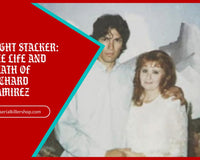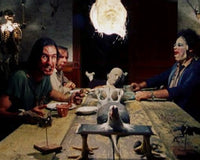When we hear the term serial killer, Ted Bundy is the first name most people think of.
Bundy is the archetypal serial killer; an intelligent, nondescript everyman who could blend in with crowds and manipulate people to his will.
The story of Ted Bundy is both tragic and fascinating, from his promising beginnings as a law student to a bloodthirsty lust killer responsible for upwards of 30 untimely deaths.
So, we've put together a biography of the most prolific serial killer in history. Here's everything you need to know about Ted Bundy.
Bundy's Childhood
Theodore Robert Bundy was born on November 24, 1946, in the Elizabeth Lund Home for Unwed Mothers in Burlington, Vermont to Eleanor “Louise” Cowell. At the time, it was considered unlawful to give birth outside of wedlock, and not only was Louise unmarried, but she was also unsure of exactly who Ted's father was.

Ted Bundy's High School Yearbook Photo
To hide Ted's illegitimacy, he was adopted and subsequently raised by his grandparents, whilst believing that his true mother, Louise, was actually his sister.
When Ted was 4 years old, Louise moved him to Tacoma, Washington, where she met Ted's future step father. Ted attended Woodrow Wilson High School and graduated in 1965. He was an average student, forgettably bland, although he achieved reasonably good grades. However, he struggled to make any close friendships.
University Life
Following his graduation, Bundy enrolled at the University of Puget Sound, a liberal arts college in Tacoma, Washington. After two semesters, Bundy felt he didn't fit in amongst the wealthy students, so transferred to the University of Washington.
It was during his time at Washington university that Bundy transformed from a shy, timid young man to the charismatic, likable gentleman he later became known for. Most of this was due to his relationship with a woman by the name of Diane Edwards.
Wealthy, good-looking and smart, Edwards inspired Bundy to better himself and for a while, he did. The two enjoyed a whirlwind romance, although it was short lived. Edwards broke up with Bundy around 1969, leaving him devestated. Edwards cited Bundy's immaturity and lack of ambition as her motivational factors.
Elizabeth Kloepfer
Around the same time, Bundy found himself back in his hometown of Burlington, Vermont. Ann Rule, Bundy's most prominent biographer, theorized that Bundy pulled up his birth records and discovered the truth about his parents.
Eventually, Bundy returned to Washington State and met a woman named Liz Kloepfer. Liz was a single parent and a secretary at the University of Washington School of Medicine. The two bonded instantly and quickly developed a deep, intense relationship.
Like Diane Edwards, Liz pushed Bundy to better himself regarding matters of education and future prospects. Bundy enrolled in a psychology course back at the University of Washington and finally left with a degree in psychology in 1972.
A Thirst For Blood
Returning to the University of Puget Sound, Ted Bundy began to pursue a law degree. He briefly rekindled his relationship with Diane Edwards (despite still being with Liz), but suddenly cut all contact with her in the fall of 1974.

Exactly when Ted Bundy's murders began is a subject of much discussion even to this day. Like many serial killers, Bundy embellished the truth after his arrest, making it difficult to ascertain exactly when he progressed to murder.
However, it was around early 1974 when young women around Seattle and Washington began to go missing. Bundy's first confirmed victim came in February of the same year.
First Murders; Washington, Oregon
Between February and August 1974, Ted Bundy killed a total of eight young women before moving onto victims in a number of different states.
In most cases, Bundy would pretend to be injured by putting his arm in a sling. He'd lure women over to help him with a physical task like loading something into his car, then he would blitz-attack, abduct and murder them.
His first killing spree consisted of the following victims:
- Lynda Ann Healy, 21 – killed on 1 February, 1974. Healy was a Washington University student whose remains were found on Taylor Mountain, Washington.
- Donna Gail Manson, 19 – killed on 12 March, 1974. Bundy later claimed to have incinerated her skull on Elizabeth’sfireplace.
- Susan Rancourt, 18 – killed on 17 April, 1974. Rancourt was abducted from the grounds of Central Washington State College. Her partial remains were discovered on Taylor Mountain.
- Roberta Parks, 20 – killed on 17 April, 1974. Parks was abducted from the grounds of Oregon State University. Her decapitated skull was discovered during on Taylor Mountain.
- Brenda Carol Ball, 22 – killed on 1 June, 1974. Bundy lured Ball into his vehicle from a small town just outside Seattle. Like many others, her skull was also found at Taylor Mountain.
- Georgeann Hawkins, 18 – missing since 11 June, 1974. Bundy later confessed to Hawkins’s murder, but her remains have never been uncovered.
- Denise Naslund, 18 – killed on 14 July, 1974. Naslund was abducted from Lake Sammamish State Park. Her corpse was later discovered found on a hillside near Issaquah, Washington.
- Janice Ott, 23 – killed 14 July, 1974. Ott was also abducted from Lake Sammamish State Park on the same day as Denise Naslund. Her body was found in the same location in Issaquah.
Police were quick to connect the missing women as the actions of a lone perpetrator. Going off eyewitness accounts from people at Sammamish Lake, police put out a composite sketch of a man seen luring women into his vehicle.
Almost 200 tips were sent to police daily, including tips from Liz Kloepfer who suspected that her boyfriend, Ted Bundy, might be responsible for the killings. But with so much intel, Bundy's name got lost in the shuffle.
Second Murders; Idaho, Utah
In August 1974, Bundy moved to Salt Lake City, Utah due to not gelling well at Puget Sound. This was the explanation he gave Liz, although the true reasons would eventually come out years later.
Bundy acquired a residence near the University of Utah campus, but would only attend law classes a handful of times over the coming months. Bundy's primary desires lay elsewhere. Over a six-week period, Ted Bundy attacked another five women, killing four of them.

Ted Bundy's house via Wikimedia Commons
- Nancy Wilcox, 16 – Missing since 2 October, 1974. Wilcox disappeared off the streets in Holladay, Utah. Bundy later confessed to raping and murdering her, then disposing of her remains in Capitol Reef Park. She marked Bundy’s youngest victim to date.
- Melissa Smith, 17 – killed on 26 October, 1974. Smith was battered, sexually assaulted beaten strangled with a nylon stocking. Her body was discarded in a mountainous area of Salt Lake City.
- Laura Aime, 17 – Missing since 31 October, 1974. Aime disappeared on Halloween night and her remains were later found frozen in the American Fork Canyon.
- Carol DaRonch, 18 – Attacked on 8 November, 1974. Bundy disguised himself as a police officer lured DaRonch into his vehicle but struggled to efficiently subdue her. DaRonch escaped.
- Debra Kent, 17 – killed on 8 November, 1974. Bundy abducted Kent outside Viewmont High School, killed her and then dumped her remains in Capitol Reef Park.
By the last of his killings, Ted Bundy had all but dropped out of law school. By early 1975, he was aware that he'd become a suspect in the recent string of murders around Salt Lake City, so he began focussing on victims further east towards Colorado.
Third Murders, Colorado
Bundy remained in Salt Lake but began venturing to Colorado in January 1975 to resume his killing spree. Across a span of six months, Bundy took the lives of another five women.
-
Caryn Campbell, 23 – killed on 12 January, 1975. Campbell was abducted from the grounds of a hotel in Aspen. Her remains were later discovered on a nearby roadside.
-
The hallway where Caryn Campbell met Ted Bundy

- Julie Cunningham, 26 – killed on 15 March, 1975. Cunningham fell for Bundy’s injury ruse, to which he abducted her, strangled her, then drove her to the city of Rifle, Colorado and discarded her body.
- Denise Oliverson, 24 – missing since 6 April, 1975. Bundy confessed to killing her and dumping her body in the Colorado River, but it was never found. All that was discovered was a pair of her sandals beneath a railroad.
- Lynette Culver, 12 – missing since 6 May, 1975. 12-year-old Lynette Culver marked Bundy’s youngest victim. He kidnapped her off the street Pocatello, Idaho, strangled her, then disposed of her in the Snake River in Central Colorado.
- Susan Curtis, 15 – missing since 27 June, 1975. Abducted after taking part in a Mormon youth event at Brigham Young University. Curtis’s body has never been uncovered, and was actually Bundy’s final confessed murder only moments before he was executed.
First Arrest
Bundy was arrested on August 16, 1975, but bizarrely, not for comitting murder, but for traffic violations. However, when the arresting police officer searched Bundy's car, he made some bizarre discoveries.
The first was that Bundy's VW Beetle had no passenger seat. The second was that Bundy had a mask, crowbar, handcuffs, ice pick and a piece of rope in his trunk. Even more incriminating was that the same handcuffs had been used to kidnap Carol DaRonch.

DaRonch testified and Bundy was sent to trial for aggravated kidnapping. Bundy was found guilty and sentenced to 1-15 years in Utah State Prison.
Officers from Washington, Utah and Colorado came together to make a case for Bundy being responsible for the serial killings across all states. Bundy, sensing that death row could be his eventual destination, made a plan to escape.
Prison Escapes
Ted Bundy broke out of jail not once, but twice - both in a span of six months.
Bundy went to great lengths to engineer the correct circumstances to allow him to escape. First, he acted as his own attorney for his trial, meaning he could wander around the courts without shackles and have access to the couthouse library to research his defense.

During a preliminary hearing on June 7, 1977, Bundy dressed himself in two layers of clothing, and during a court recess, Bundy escaped out of the courthouse library window. He removed his first layer of clothing and headed to the Aspen Mountains. He lasted six days before police found him.
Bundy escaped from prison again on December 31, 1977. Still awaiting trial, this time in Garfield County Jail in Glenwood Springs, Colorado, Bundy managed to climb into a crawlspace above his prison cell and maneuver his way out of the building.
Chi Omega Sorority House Killings
This time, Ted Bundy made his way to Tallahassee, Florida, and it was here that he committed his most ruthless and impulsive killings.
Having been incarcerated for two and a half years, Ted Bundy's bloodlust was at an all-time high. It was now January 1978, and Bundy's last victim was killed in June 1975.
In the early hours of the morning, Bundy made his way to the Chi Omega Sorority House. He picked up a log from outside the building and made his way inside. He relentlessly attacked four women, fatally wounding two of them.
- Margaret Bowman, 21 – killed 15 January, 1978. Bundy assaulted Margaret Bowman with his weapon then strangled her to death.
- Lisa Levy, 20 – killed 15 January, 1978. Bundy assaulted and killed Levy in the same manner as Bowman. He also bit off one of her nipples.
- Kathy Kleiner, 20 – attacked on 15 January, 1978. Bundy bludgeoned Kathy Kleiner with his weapon with such brutality that it left her jaw hanging off. Kleiner survived the attack.
-
Karen Chandler, 22 - attacked on 15 January, 1978. Chandler and Kleiner were roommates and Bundy assaulted them both at the same. Chandler suffered a broken jaw, broken arm, and four dislodged teeth, but survived.

Despite this impulse-driven massacre, Bundy wasn't done. He broke into the apartment of 21-year-old Cheryl Thomas, located eight blocks from the sorority house. He bludgeoned her as he had done the others, but Cheryl fortunately survived.
Final Murders & Arrest
On February 9, 1978, Ted Bundy committed his known final murder. Bundy abducted 12-year-old Kimberly Leach from the grounds of Lake City Junior High School. Her mummified remains were discovered seven weeks later beneath a pig shed near Suwannee River Park.
With suspicions that police were closing in on him, Bundy fled Tallahassee, Florida three days later after commandeering a stolen vehicle. However, his car was flagged as stolen as he attempted to cross over into Alabama.
A panicked Bundy then attacked the officer and attempted to flee, but he was quickly apprehended. Inside his vehicle, the officer found a number of ID cards belonging to female Florida students. Unbeknownst to the officer, he'd just arrested one of the most heinous serial killers in history responsible for 30+ murders across seven states.
Trial & Sentencing
Authorities had suspicions that Ted Bundy might have responsible for the Chi Omega mass attacks, as well as other murders across the country, but they were unaware of the true extent of Bundy's crimes.

It took a number of years for prosecutors to compile all of the necessary evidence to charge Bundy. The trial eventually took place in July 1979. Throughout the trial, Bundy served as his own attorney as he had done previously.
Prosecutors called upon a number of witnesses, including Chi Omega sorority sisters who witnessed Bundy in their residence the night of the attacks. The most damning piece of evidence was that the bite marks on Lisa Levy's buttocks matched Bundy's dental cast.

After seven hours of deliberation by the jury, on July 24, 1979, Bundy was found guilty. Two counts of first-degree murder and three counts of attempted first-degree murder. A week later, Ted Bundy was sentenced to death by electrocution.
Confessions & Execution
In the months leading up to Bundy's execution, officers from Utah, Colorado and Idaho interviewed him extensively regarding the span of his crimes. Bundy confessed to more murders than even the police were aware of.
He told police how he would often return to the murder sites to spend time with the bodies of his victims. In some cases, he applied make-up and washed the bodies before sexually violating them.
Once Bundy realized he could use this to his advantage, he continued to feed the police cryptic information in an attempt to delay his date with the electric chair.
However, authorities soon became wise to Bundy's game, especially as most new information he was feeding them yielded no results. On the morning of January 24, 1989, Ted Bundy was executed by electric chair.
Ted Bundy In Popular Culture
Ted Bundy's life and crimes have been the subject of countless books, documentaries and movies over the past thirty years. Here's a short list of the most notable projects, and even some Ted Bundy shirts.
Ted Bundy Movies
- The Deliberate Stranger (1986)
- Bundy (2002)
- Ted Bundy: Natural Porn Killer (2006)
- Extremely Wicked, Shockingly Evil and Vile (2019)
Ted Bundy Books
- Ann Rule - The Stranger Beside Me (1980)
- Elizabeth Kendall - The Phantom Prince: My Life with Ted Bundy (1981)
- Hugh Aynesworth, Stephen G. Michaud - The Only Living Witness: The True Story of Serial Sex Killer Ted Bundy (2012)
Ted Bundy Documentaries
Want more true crime? Check out our true crime shirts, then read about these 9 currently active serial killers.













2 comments
Sophie
Am still trying to understand why he did all that
Sabikun
I want to know the motive, he was so notorious but his motive is not clear to me.